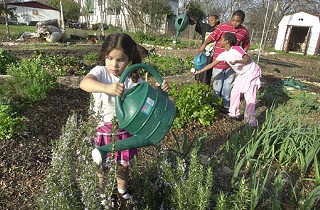Planting a Seed
Local schools see students not only eating all of their vegetables but growing them, too
By Mick Vann, Fri., March 23, 2007
Back in the day, in generations before the baby boomers, people had an intimate knowledge of the farming process: They knew where their food came from, and more than likely, they had a friend or relative who was a farmer or rancher, especially in Texas. There was no question of eating seasonally; it was the only option (unless you count produce that was in a mason jar). Victory gardens during World War II were considered patriotic, and even in the cities, there was one on every vacant lot.
Baby boomers, at least those who didn't spend all of their time in a city, can easily recall relatives or even their parents having gardens. They probably had a friend in the hippie days who grew an organic garden. There is still a connection for their age group between farm and table.
Most Generation Xers and their juniors rarely have a clue where their food originated. Unless their parents are enlightened gardeners or they live in a rural area where farming or ranching still happens, there is no season for a particular food, and all food groups are fast, processed, and microwaveable (or cooked in a vat of bubbling oil).
It's this disconnect between farm and plate that led Alice Waters, of Chez Panisse Restaurant and Cafe fame, to organize the Berkeley community around the Edible Schoolyard (www.edibleschoolyard.org) at Martin Luther King Jr. Middle School. She saw a huge paved parking lot as a spot for a possible 1-acre organic garden with a kitchen classroom, where the kids could cook what they had grown. She had a vision of kids learning about sustainable agriculture, seasonal eating, ecoliteracy (www.ecoliteracy.org), and environmentally conscious thought and action. What she created, with the help of a whole community of like-minded supporters, has become the pilot project that most of the programs in Austin and around the country strive for. Every person interviewed for this story sang her praises and considered her an inspiration.
UT Child Development Center
East of the University of Texas campus sits a school that serves the children of UT faculty, staff, and students, and they start teaching them about gardening at a very young age. It was completed in 2005, and the gardens, small as they are, were finished shortly after the school opened. Instructor Janie Murillo and center director Sandra Lynn Briley have a couple of small rectangular beds (10-feet-by-4-feet) and some space in landscape beds that can also be utilized for vegetables, flowers, and herbs. Murillo likes to garden the most, and since she works with the toddlers (18 months to 2 years), they are in the garden more than any other group, although any age group at the school is welcome.
For the littlest tykes, it's mostly about just being outside, but they can dig some very respectable holes with their miniature shovels. For older age groups, it's used mostly for ecology, science, and learning where food comes from. The kids have eaten some of the crops – cauliflower, spinach, and a few bell peppers – and all love to smell the rosemary and lavender plants. "Rain barrels are used whenever possible for garden water, so we can teach them about rainwater harvesting, water conservation, and the water cycle," Briley says.
"We love having the beds here, and the kids can't wait to get out here to work in the garden. I want to grow a small plot of corn this spring. Even if it doesn't work out, the kids will learn from failure," Murillo says.
Another option for hooking the kids at an early age is enrolling them in local alternative education schools, such as Ronda's Montessori Garden ([email protected]). Ronda Dizney deals with tykes 18 months to 6 years old and gets them involved with growing organic herbs and vegetables, while raising chickens and rabbits, making soaps, etc. Alice Waters stresses that alternative schools such as Montessori and Waldorf have been at the forefront of using gardens as an interactive learning tool from the beginning.
When you think about it, a produce garden at a school makes a lot of sense. It's the perfect hands-on laboratory for all kinds of practical learning applications, and it's outside in the fresh air, with a change of scene from a cooped-up classroom. Most classes keep journals, so language and writing (and observational) skills are reinforced. You must know some math to garden successfully: geometry to figure out the square footage of the growing areas, in order to calculate the amount of materials and soil amendments required; you have to figure out the number of days to seed germination, as well as to maturity and harvest, and how many seeds are needed to acquire the proper spacing of plants within the row.
Consider meteorology: Seasons have different lengths of photoperiod (number of hours of daylight), and the angle of the sun changes. To be prolific, different fruits require certain numbers of chilling hours. Seeds need a set range of soil temperatures to sprout and the proper amount of moisture and rain. You have to be able to understand a weather report to know how cold it will get, and if your baby plants will freeze or suffer wind damage.
Soil science is a no-brainer: Different crops thrive in different soil pH levels. The physical makeup of the soil and the chemical nutritional analysis determines the amendments needed. How do soil drainage, mulch, and compost affect the amount of water required? You can follow the same process with plant science, chemistry, ecology, or any other branch of science that you can think of.
The bottom line, and the thing that Waters is most concerned with, is the science of nutrition. With children becoming overweight and obese and eating the wrong things more often, a few lessons in proper nutrition seem to be a natural progression of growing fresh vegetables (and some exercise in the garden couldn't hurt either). She has the luxury of having a full kitchen and a pizza oven (with a full cafeteria on the way), while many of the local gardens have to settle with bites of fresh raw vegetables.
The Green Classroom & Earth Camp
Carla Marshall started the Green Classroom in 1989. The city's Watershed Protection Development Review, Becker Elementary School, the Green Classroom Organization, and neighborhood volunteers now run the program. Kathy McWhorter and Paula McDermott are the coordinators, with assistance from about 15 Bouldin Creek Neighborhood garden volunteers and other school staff, such as Megan Sembera, the science teacher who is in charge of the fourth- and fifth-graders. A much larger group of other volunteers from the neighborhood help with special projects and maintenance. The Green Classroom is winner of multiple President's Awards, and the curriculum has been adopted by third-, fourth-, and fifth-graders at schools throughout the city.
It sits across the street from Becker Elementary, behind a little house, and features perennials, herbs, vegetables, a pond, compost-production bins, and a rainwater-harvest system. "There are about 20 small plots, with the average being about 3-feet-by-4-feet. We harvest almost continuously and try to eat something from the garden at least once a week," McDermott says. "I volunteer to work with the fourth-graders, and we have groups of around 20 out there gardening and learning in 45-minute sessions. The curriculum is fairly free-form, and there can be kids from K through fifth grade out there. We talk about the different grades' curriculum needs and adapt them to what the kids require."
Earth Camp (www.ci.austin.tx.us/watershed/ecdesc.htm) is an Austin WPDR program that teaches hands-on lessons regarding watershed protection to some 500 Austin Independent School District fifth-graders annually; kids come to the Green Classroom twice a week and work on the compost for the Green Classroom, tour the gardens, pull weeds, mulch, and learn the difference between beneficial and bad insects. The compost is a product of neighborhood leaves and clippings and organic refuse from the Soup Peddler, delivered to the site by volunteers from the neighborhood. The Earth Camp is all about teaching kids the different ways that our water supply can be protected. American YouthWorks, a local GED-fulfillment program, will soon help remodel a toolshed for the garden and do some decorative stone work.
Alamo Community Garden
Vegetable gardens don't have to be formally associated with a school for the kids to learn from them. Good examples are the organic garden plots built by volunteers from the Sustain-able Food Center (www.sustainablefoodcenter.org)
. SFC's Community & Youth Gardening program offers resources and education to enable neighborhood kids (and adults) to develop skills in organic gardening and environmental awareness. They operate three community gardens: Southeast Metro Park (1.5 miles past the intersection at FM 973 on Highway 71), El Jardin Alegre Community Garden (1801 E. Second), and Alamo Community Garden.
With their Youth Gardens project, SFC currently works mainly with elementary schools, but they are slowly expanding into middle and high schools. Each week, SFC volunteers meet kids from Sanchez and UT elementary schools in the gardens, with the students doing the planting, maintaining, and harvesting. The kids get to sample the produce and get to make a dish using their harvest. They are also encouraged to share their harvest with local community shelters.
The gardens at Sanchez Elementary (73 San Marcos St.) were constructed by SFC in 2002. This garden of 20 raised beds provides an interactive educational area for third- through fifth-grade students to learn basic concepts in science and organic gardening. The gardens at UT Elementary School (2200 E. Sixth) were built in early 2006. With 20 raised beds, it allows more than 160 kindergarten through third-grade students to participate in weekly garden-based, interactive activities.
Alamo Community Garden is located just east of Alamo Park, at Alamo and 21st. It offers 14 plots, a demonstration "pizza" garden, a wheelchair-accessible horticultural therapy bed, an educational compost station, and a rainwater collection site. Plots are leased out at a very inexpensive cost to neighbors, while some plots are used by kids from the Alamo Park Recreation Center across the street (with volunteer supervision from SFC staffers). Produce gets donated to the elderly in the neighborhood.
We joined SFC's Community & Youth Gardening program director Karen Banks and her assistant, Emily Neiman, while they were double-digging a bed at Alamo to get it ready for spring planting on a cool, windy afternoon in February. "We are only one generation away from losing all connection with the farms. With the kids who garden here and at our other gardens, we know that they come away with an understanding of where their food comes from and an appreciation of how important it is to have fresh, organic vegetables to eat."
Neiman pointed out the positive influences of gardening for kids, backed up by extensive studies at Texas A&M and Virginia Tech: "Improved environmental awareness; better nutritional attitudes, better diets, and a love of vegetables and fruits; improved self-esteem; achievement test-score averages rise; better attitudes toward school attendance and class participation; interpersonal skills and social interaction; awareness of social concerns; improved behavior; positive changes in attitudes about personal success. In every category there were positive changes."
Redeemer Lutheran School
The beautiful gardens at Redeemer (www.redeemerschool.net) started five years ago as naturescapes, but herbs and vegetables were added to include a nutrition element. Four large gardens are used to raise herbs for Meals on Wheels and More, while three other large gardens are used to raise vegetables, which are used in the school-lunch program. This spring they will add tubs to grow potatoes and tomatoes. "With 500 kids in school, there is never enough to feed everyone, but we do taste things constantly, and one little nibble can make a huge impact with a child, especially when they grew what they are tasting. I cook with the kids, and they get to taste everything we grow," says garden director Danna Keyburn.
All grades are involved with the garden, from third to 10th, and there is a garden club with some 30 student volunteers who show up every Thursday to work. "We just got a huge composter donated, which will make a big difference for the seventh-graders who do the composting," says Keyburn.
Garza Independence High School
To take the whole curriculum to a higher level, we look at the horticultural program offered at Garza Independence High School (www.austinschools.org/campus/garza/index.html), an alternative high school education facility. Martha Cason is the faculty head, and the 9-year-old gardens are used to not only grow produce as part of the horticulture program, but they sell what herbs they grow at the Austin Farmers' Market Downtown as a practical element of the curriculum, incorporating agribusiness management and marketing.
"The kids decided to build vegetable beds, using AISD agricultural science funds, and those beds were enlarged again this year. We currently have 24 beds, and plan on adding another 12. The cafeteria agreed to cook the vegetables we produce, and the kids love the fresh food. Once we get the other 12 beds added, we can make a difference in the lunch costs," Cason says. "We are trying to eventually get certified 'organic' by [the Texas Department of Agriculture], but the most important thing is for us to truly become a neighborhood resource center: a place to lend garden tools and books, to provide compost, and teach the neighbors through workshops."
YouthLaunch Urban Farm
SEEDS is an afterschool gardening program at Webb Middle School, run by YouthLaunch (www.youthlaunch.org), where students work in an organic garden, learning about the environment and sustainability through service projects. Max Elliott, program specialist, is starting an ambitious new project. YouthLaunch is trying to establish a 2- to 3-acre farm in East Austin for underserved 14- to 18-year-old kids, who are hired as paid interns. The goal is to establish the farm as a teaching tool to grow and distribute food.
They intend on producing herbs, vegetables, and fruits, which will be shared in the community and marketed at local farmers' markets and farm stands. Combined with field trips, workshops, and hands-on training, the program will operate in 12-week sessions fall and spring, with an intensive six-week summer course.
Green Corn Project
Although Green Corn Project (www.greencornproject.org) deals more with private and community gardens instead of school gardens, it has been used as a model for many of the programs that have been established to educate kids with gardens. Since the project was founded in 1998, GCP has built more than 100 gardens in Austin's underserved neighborhoods. Amy Crowell, executive director, says that GCP also serves as an educational clearing house, teaching weekend bio-intensive gardening workshops and hosting "Dig-In" garden-construction events. GCP's goal is to teach effective techniques for growing food at home naturally, while making maximum use of land, water, and energy. ![]()









